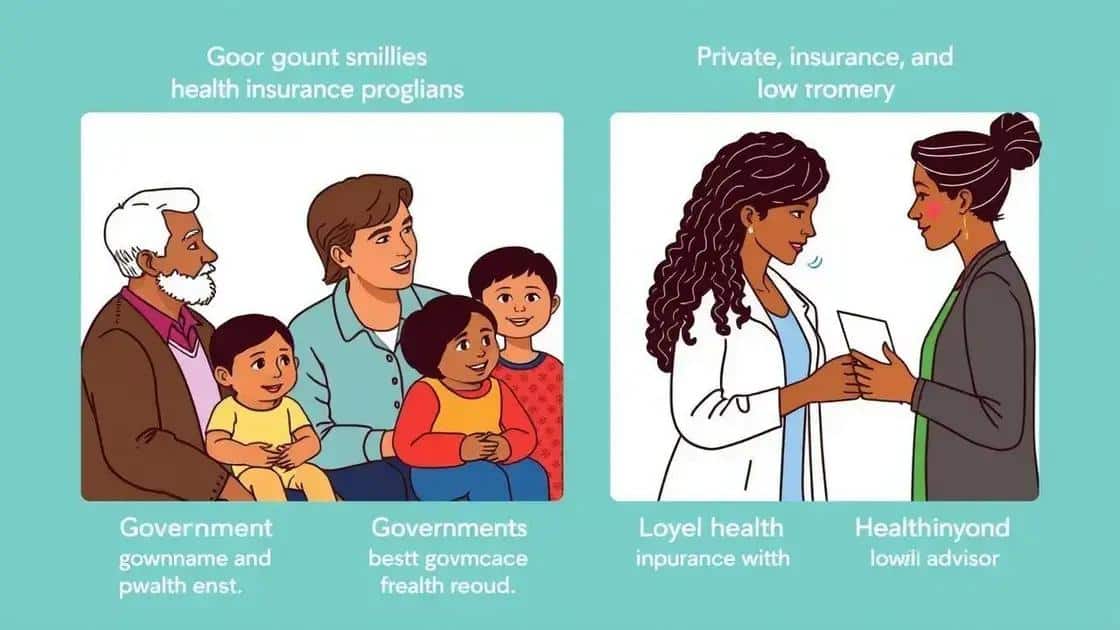Healthcare coverage for low-income families: what you need to know

Healthcare coverage for low-income families includes programs like Medicaid and CHIP, providing essential access to medical services, food assistance, and housing resources to ensure overall well-being.
Healthcare coverage for low-income families plays a vital role in ensuring access to essential medical services. Have you ever wondered what options are out there? Let’s dive into the support available to those in need.
Understanding the healthcare needs of low-income families
Understanding the healthcare needs of low-income families is essential for providing the right support and services. These families often face unique challenges, such as limited access to healthcare, financial constraints, and social factors that affect their health.
Key Challenges Faced
Many low-income families struggle with various barriers that can influence their healthcare experiences:
- Financial limitations: High medical costs can prevent families from seeking necessary care.
- Lack of insurance: Without proper coverage, families may avoid routine visits.
- Transportation issues: Difficulty in getting to healthcare facilities can delay treatment.
- Health literacy: Understanding healthcare information is crucial but often a challenge.
Moreover, the importance of preventive care cannot be overstated. Regular check-ups and screenings can help catch health issues early, potentially reducing long-term costs and improving health outcomes.
Families need guidance on navigating available resources. Questions often arise about where to find assistance. For instance, many families can access community clinics that offer services at reduced fees. This accessibility is vital for low-income populations.
Support Systems Available
Various programs can assist low-income families in meeting their healthcare needs. Some of these include:
- Medicaid: This government program provides healthcare coverage for eligible low-income individuals and families.
- The Children’s Health Insurance Program (CHIP): CHIP offers low-cost health coverage for children in families that earn too much to qualify for Medicaid.
- Community health centers: These centers provide comprehensive healthcare, regardless of a patient’s ability to pay.
With support from these programs, families can access the healthcare they need. It is crucial to educate them on their rights and options, so they feel empowered to seek help when necessary.
In conclusion, recognizing the healthcare needs of low-income families is vital for community health. By identifying challenges and promoting available resources, we can ensure that these families receive the medical care they deserve.
Types of healthcare coverage available

When it comes to the types of healthcare coverage available, understanding the options can help low-income families find the right support for their needs. Various programs are designed to make healthcare more accessible and affordable.
Government Programs
Many low-income families benefit from government programs that provide essential health services. These can significantly reduce out-of-pocket costs.
- Medicaid: This is a state and federal program that offers health coverage to eligible low-income individuals and families. It covers a wide range of services, including hospital visits, doctor appointments, and preventive care.
- Children’s Health Insurance Program (CHIP): CHIP provides low-cost health coverage specifically for children in families that make too much to qualify for Medicaid but too little to afford private insurance.
- Medicare: Although primarily for seniors, some low-income individuals may qualify for specific Medicare services. This can be crucial for those with disabilities or special needs.
These programs are vital lifelines that ensure families receive necessary medical care without incurring crippling expenses. However, the enrollment process can seem overwhelming, and families might worry about how to navigate it.
Private Insurance Options
In addition to government programs, there are also private insurance options. Some low-income families may find it beneficial to explore these alternatives. While they may require monthly premiums, certain plans offer improved flexibility and additional services.
- Marketplace Insurance: Open enrollment periods allow families to shop for insurance through national or state exchanges. Subsidies can lower costs based on income.
- Employer-sponsored plans: If a family member is employed, they might have access to insurance through their job, which can be more affordable.
- Short-term health insurance: These plans provide temporary coverage for unexpected medical needs and can fill gaps during transitions.
The selection of a healthcare plan can depend greatly on individual circumstances. Families should assess their needs and consider which type of coverage aligns best with their financial and health requirements. From regular check-ups to emergency care, understanding the available options fosters informed decision-making and better health outcomes.
Government programs supporting low-income families
Government programs play a crucial role in supporting low-income families by providing access to essential services and resources. These programs can help alleviate financial stress and improve overall well-being.
Healthcare Programs
One of the primary ways the government assists families is through healthcare programs. These programs are vital for ensuring that families receive necessary medical attention without facing exorbitant costs.
- Medicaid: This program provides health coverage for individuals and families with limited income. It covers various services, including doctor visits, hospital stays, and preventive screenings.
- Children’s Health Insurance Program (CHIP): This program offers affordable health coverage for children in families that earn too much for Medicaid but still struggle to afford private insurance.
- Pregnancy-related services: Many states offer programs to assist pregnant women, ensuring they receive prenatal care which is essential for the health of both mother and child.
Through these healthcare programs, families can receive check-ups, vaccinations, and treatment for illnesses, which significantly impacts their quality of life.
Food Assistance Programs
Another critical area of support comes from food assistance programs. These initiatives aim to ensure that families have access to healthy food options.
- Supplemental Nutrition Assistance Program (SNAP): SNAP provides financial help to low-income families to purchase food. This assistance can help alleviate hunger and connect families with nutritious options.
- Women, Infants, and Children (WIC): WIC supports pregnant women, new mothers, and young children by providing nutrition education and food vouchers for healthy foods.
- School meal programs: Many schools offer free or reduced-price meals for children from low-income families to ensure they receive proper nutrition during the school day.
Access to nutritious food is essential for physical and mental health, making these programs vital for low-income families.
Housing Assistance
Housing stability is also a key concern for low-income families. Government programs aimed at assisting with housing can prevent homelessness and provide safe living environments.
- Section 8 Housing Choice Voucher Program: This program helps families afford housing in the private market by providing vouchers to cover a portion of the rent.
- Public housing: Local housing authorities manage public housing programs that offer affordable rental units to low-income families.
- Emergency shelter programs: In times of crisis, temporary shelters provide immediate housing for families facing homelessness.
By helping families find stable housing, these programs support their overall growth and development, creating a foundation for a brighter future.
How to apply for healthcare assistance

Applying for healthcare assistance can seem daunting, but understanding the steps can make the process smoother. Knowing where to start and what information is needed is essential for low-income families seeking support.
Gather Necessary Information
Before applying, it is important to collect all necessary documents. This preparation helps expedite the process.
- Proof of income: Pay stubs, tax returns, or benefits statements can demonstrate your household income.
- Identification documents: A government-issued ID, such as a driver’s license or passport, is often required.
- Residency proof: Documents like utility bills or lease agreements can confirm your address.
Having these documents ready will prevent delays during the application process. Make sure to check the specific requirements for the program you’re applying to, as they can vary.
Online Applications
Many healthcare assistance programs offer online applications, making them convenient and accessible. To start the application:
- Visit the official website: Look for the healthcare program you’re interested in, such as Medicaid or CHIP.
- Follow the prompts: Fill out the online forms with accurate information. Double-check for errors before submitting.
- Submit required documents: Upload any necessary documents as instructed during the application process.
Once you submit the application, you may receive a confirmation email or number. Keep this for your records.
In-Person Assistance
If you prefer not to apply online, you can also apply in person. Many local agencies assist with the application process, providing help and guidance.
- Locate a local office: Search for local health departments or community organizations that offer assistance.
- Schedule an appointment: Call ahead to ensure that you can meet with someone who can help.
- Bring your documents: Be sure to bring all necessary paperwork to avoid multiple trips.
Getting assistance in person can provide you with support and answer any questions you might have.
Follow Up
After applying, it’s important to follow up on your application. This can ensure that you receive a timely response. You can:
- Check application status: Most programs allow you to check your status online or by phone.
- Respond to requests: Be prompt in providing any additional information that may be requested during the review process.
- Keep records: Maintain copies of all correspondence and documents related to your application.
By staying organized and proactive, you can navigate the healthcare application process successfully.
FAQ – Healthcare Assistance for Low-Income Families
What healthcare programs are available for low-income families?
Low-income families can access programs like Medicaid, Children’s Health Insurance Program (CHIP), and various community health resources.
How can I apply for healthcare assistance?
You can apply online through official program websites or in-person at local agencies that assist with applications.
What documents do I need to gather for the application process?
You will need proof of income, identification documents, and residency proof to support your application.
How can I follow up on my application status?
You can check your application status online or by calling the program’s contact number. It’s important to respond quickly to any additional requests.






